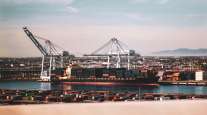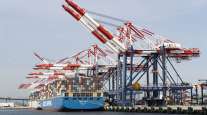Senior Reporter
Ports Post Strong November Volumes as Imports Continue to Surge

[Stay on top of transportation news: Get TTNews in your inbox.]
Atlantic and Pacific ports in November continued their record-setting pace as imports continue to flood into the country during the peak of the holiday shopping season.
The nation’s busiest facilities, the ports of Los Angeles and Long Beach, reported volume dips in 20-foot-equivalent units, even as the number of ships delivering boxes remained strong.
Port of Los Angeles Executive Director Eugene Seroka said Dec. 15 the port in November had a year-over-year 8.8% drop to an estimated 811,706 containers from last year’s 889,746. However, the port saw a 20% increase in smaller containerships, many in the 5,000-TEU range, instead of vessels carrying 10,000 or more.

Seroka
“Of the 86 container vessels that arrived last month, half were less than 5,300 TEUs, and for comparison,” Seroka said, “in October, about one-third of the ships were that size.”
Seroka also said the two ports’ proposal to impose fees on shippers that do not pick up their empty containers at the ports still is on the table, but he says the number of empty boxes is down 56% in the past two months.
Los Angeles also is on track to eclipse 10 million TEUs for the first time in its history.
The Port of Long Beach reported a 4.8% decrease in container volume in November, processing 745,488 units compared with 783,523 last year. Long Beach also is on track to process more than 9 million cargo containers by the end of the year, compared with a record-setting 8.1 million in 2020.
“Clearing the line of ships waiting to enter our port and moving containers off the docks are our top priorities to ensure shelves are stocked and consumers can purchase gifts during the holiday season,” Port of Long Beach Executive Director Mario Cordero said.

Trucks carry cargo at the Port of Long Beach. (Marcio Jose Sanchez/Associated Press)
Meanwhile, some two months after the White House announced a plan to ramp up both ports to 24/7 operations, the program is still lagging. Seroka said only one of the seven terminals has met that goal and he said coordinating the various steps in the supply chain, including trucking, and availability of warehouse space is hampering the effort.
November’s container numbers for the Port of Oakland were down 4.5% compared with a year ago as workers moved 189,111 TEUs and in 2020 workers processed 197,695. However, the current figure is a 9.1% increase over October, when several ships skipped scheduled trips to Oakland. Instead, they headed back to Asia to get additional cargo because Pacific Ocean shipping rates are three times as high as they were a year ago.
The port said that 75 ships called on Oakland in November, the most in six months.

Brandes
“We’re gratified that shipping lines and cargo owners recognize the value of coming to the Port of Oakland,” Maritime Director Bryan Brandes said. “We’re working hard to move their cargo efficiently as ports elsewhere face headwinds.”
On the East Coast, the Port of Virginia said it processed 290,759 containers, making that the best November in the port’s history and up 3.9% over the same month in 2020. Imports were up 13.1% year-over-year. With one month left, the port is on track to move nearly 3.5 million containers and that would be a 13% jump from 2020’s record of 2,813,415.
Officials also announced they have approved an $80 million rail expansion for the Central Rail Yard at Norfolk International Terminals that will increase container volume and deepening and widening the port’s main channel. The rail yard project should be complete by late 2023 and the dredging by 2024.
Processing nearly 291,000 TEUs, November's volume was the highest of any November in our port's history. We are also moving forward with critical infrastructure projects to expand our rail capacity and deepen and widen our channels.https://t.co/WDrGu46pGt#maritime #shipping pic.twitter.com/gjg6V8l8Ow — The Port of Virginia (@PortofVirginia) December 13, 2021
Georgia’s Port of Savannah continues its steady growth and, based on November numbers should easily surpass 5.5 million container mark by the end of the year, compared with 4.68 million a year ago. The port moved 495,749 TEUs in November, compared with 464,804 a year ago.
The Port of Charleston processed 250,711 containers in November, a 21% increase from last year’s 207,066.
As ports on the West Coast continue to grapple with backlogs, the Port of Baltimore on Dec. 13 announced it is ramping up cargo volumes to help relieve backlogs at other ports.
In another way of helping ease the unprecedented supply chain congestion at other ports, the Port of Baltimore has received 26 ad hoc ships since July 2020-- vessels diverted to Baltimore that weren't on a regularly scheduled call. https://t.co/5vOywkZp77
#Open4BizMD pic.twitter.com/roryQhCSEG — Port of Baltimore (@portofbalt) December 15, 2021
The port berthed the cargo ship Noble Ace, then workers unloaded 1,800 new Mercedes-Benz vehicles — about 600 of which are destined for the West Coast.
“The international maritime industry believes in the Port of Baltimore, and this increase in business reflects that confidence,” Maryland Gov. Larry Hogan said. “Throughout the pandemic, the men and women who work at Maryland’s port have maintained it as a solid, reliable link in our nation’s supply chain.”
Want more news? Listen to today's daily briefing below or go here for more info:




